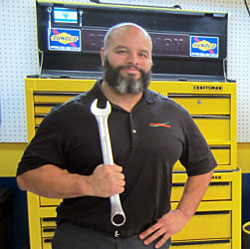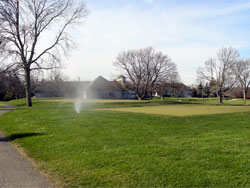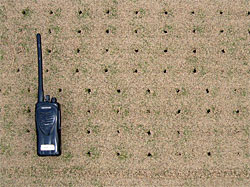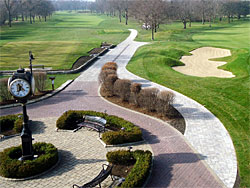 |
December 4, 2012
|
|
New Equipment Manager - Hector Velazquez Jr...
Scott Rettman, Walnut Creek Country Club, South Lyon, MI:
 "It's with great pleasure that I announce our new Equipment Manager, Hector Velazquez Jr. Hector comes to us from Thorntree Country Club in DeSoto, Texas where he is currently the Golf Course Equipment Manager. He has 13 years of experience as an Equipment Manager at golf clubs around the U.S. and is well respected by his peers. In his spare time, Hector produces videos for TurfNet.com about equipment maintenance, new products, and helpful tips for other Superintendents and Equipment Managers around the globe to use and share ideas.
We're very excited to welcome Hector to the team at Walnut Creek CC and look forward to working with him for years to come!
To learn more about Hector and watch his videos on equipment maintenance , please visit his website at: www.hectorsshop.com."
Visit Scott's blog at wcccturf.blogspot.com.
|
 |
|
#1 Tee Renovation...
Brandon Collins, Country Club at Woodmore, Mitchellville, MD:
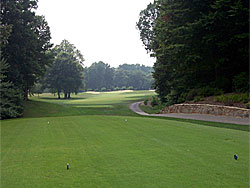
The old tee (above) aligned players directly at the grouping of trees on the right of the hole. Below, taken from the back center of the new tee location. The existing turf you see is the far left side of the old tee box.
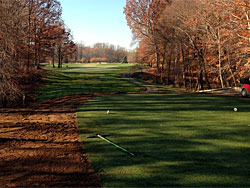 |
 "If you have been out to the golf course in the last couple of days you may have noticed a major change taking place on the first tee. We started to renovate the tee complex last Monday.
There are several reasons for this renovation. The major factor was playability. I'm sure that when the course was constructed, a player could hit a cut or a draw off of the main tee box. Thirty years later however, the trees have grown so large that a player is forced to play a left to right shot or end up in the left rough if they can only hit a draw. In addition to this, the tee has always been misaligned and off center. As you can see in the picture above (taken during the summer), the tee is aimed directly at the trees on the left side of the hole. Because of the location of the tee box, 50 percent of the tee surface was not usable as it was blocked out by trees. Plant health has also become an issue as the trees have grown larger. There is simply too much shade for the zoysia on this tee to survive. The thinning stand of desirable turf also has resulted in a large infestation of weeds the last several summers.
So what are we doing to alleviate these issues? We are turning our current single, large tee into two smaller tees. The pro tee will be elevated and shifted slightly left and back. The low handicap player who plays these tees will still have to hit a cut but it will be less severe. The blue/white tee will moved drastically left. The second picture above shows the tee will be aligned directly down the middle of the fairway, allowing higher handicap players to hit the shot that they feel the most comfortable with.
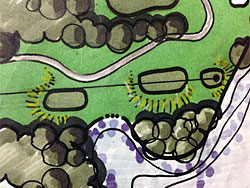
Ault, Clark and Associates rendering of the first tee complex. |
While I would like to take credit for the redesign of the hole, it would not be true. This design was actually proposed to the Club in a master plan done by Ault, Clark, & Associates in 1999. Below is their rendering of the improvement.
The best aspect of this project is perhaps that it is being completed at virtually no cost to the Club. We are using our own equipment and staff. We will slightly shorten the fairway on the front of #4 to get sod for the project. Any soil we need is being mined from a drainage project on #1 that we are doing in conjunction with the tee renovation. Getting this done at the same time is just a bonus. So as you can see, we had to get a little creative when it came to finding resources but we are making it work.
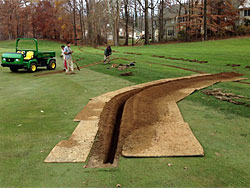
Soil being mined from the left side of the first fairway to use on the tee renovation. |
We expect to have the tee sodded in the next couple of weeks but due to the cold weather, it will not be rooted enough to be playable for quite some time. While the sod is taking hold, the Golf and Green Committee has approved the use of a range mat off of the first tee. Check back often as we will be updating our progress regularly. Thank you for your continued support, understanding, and patience as we continue to improve the golf course!
Visit Brandon's blog at ccwoodmoregcm.com.
|
 |
|
Winterizing the irrigation system...
Steven Biehl, Naperville Country Club, Naperville, IL:
 "Another piece of the winterizing puzzle was put in place yesterday with the completion of the irrigation system. We finished in the moon light, which isn't saying much, it is out at 5pm now. Winterizing the irrigation system is not difficult, but it is important to do a thorough job. When water freezes, it expands; and the plastic components of the irrigation system were not designed to expand. Ensuring that all the water is out of the pipes, heads and valves makes for an easier start to the year in the spring.
We do not winterize our pump station. This provides the water for our fire sprinklers in the maintenance facility. The pump station remains on and operational through the winter. This does require a little extra work to cover vents and make sure the heater and thermostat are working."
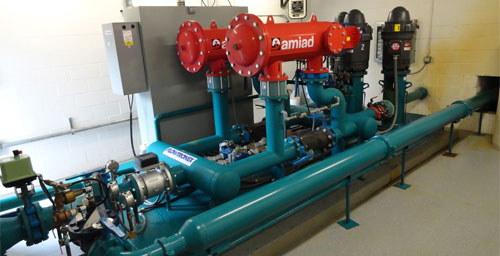
Visit Steven's blog at napervilleccgrounds.blogspot.com.
|
 |
|
Fall Activities...
Greig Barker, Highland Country Club, London, Ontario:
"Despite the unpredictable weather that the fall brought the London area, our department was been successful in working away at a number of winter preparation tasks.
Greens:
Early in the fall we performed a deep verticut on our greens to reduce organic matter and increase the potential for sand incorporation (during the topdressing process). This practice worked out very well and we will be utilizing it again in the spring of 2013.
Our fall Deeptine/Vertidraining of greens was completed as well. This process opens up deep 8" channels to allow for compaction relief, air and water flow as well as sand incorporation deep into the profile. As always this process was preceded with a generous topdressing.
We preferred to not mulch leaves in areas that the rough tends to struggle during the season (typically under larger trees)... |
We applied Manganese Sulphate and a Magnesium product to help elevate these nutrient levels in the soil in preparation for next season. If the weather permits we will be applying one more topdressing of sand prior to installing the permeable greens covers.
Tees/Approaches:
Cultural practices on tees and approaches this fall have included a deep verticut, deeptine aeration and topdressing. All have been completed once to date.
Following our snow mold preventative application, we applied a heavy topdressing of sand and left it on the surface for the winter. This process allows the sand to protect the crowns of the plant in the absence of snow cover and/or permeable covers.
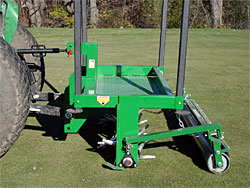 |
Fairways:
Unpredictable weather and staff limitations prevented us from doing such tasks as deep verticutting this fall. We will be performing a deep verticut in the spring of 2013. We have however completed a deep slicing with our Superject aerator. This process allows for compaction relief and slices in the soil for air and water movement.
Roughs:
This fall we were diligent with our leaf blowing and mulching regime. We preferred to not mulch leaves in areas that the rough tends to struggle during the season (typically under larger trees). We have made a conscious effort on improving these rough areas throughout the season. Overseeding, leveling and extra fertilization has improved these areas. In continuance with this process we will be adding some extra dormant fertilizer to the roughs this fall to help improve density.
All but a few leaves have fallen, we have blown and mulched almost to the point that the golf course is free of leaves. This is to help in preparing for a nice clean, healthy golf course come the 2013 season.
Visit Greig's blog at highlandccgroundsdept.blogspot.com.
|
 |
|
Path completed and first snow...
Shane Conroy, asst supt, Park Ridge Country Club, Park Ridge, IL:
 "The path addition on holes one and 18 is completed. Yesterday we finished cutting the bricks and this morning we put down the remaining sod. Traffic is still routed to two specific places (leaving number one and entering from 18) due to the new sod, so we please ask that you follow the traffic arrows that are set up.
The Chicagoland area received its first snowfall of the season overnight on Nov 13. There was not a large amount of snow but enough to cover the bentgrass. The turf is still susceptible to winter damage if walked or driven on. As the year goes on and the temperature continues to drop, the grass plants will go dormant and begin to harden off. When turfgrass is in its dormant state the possibility of winter damage still exists; however, the probability decreases.
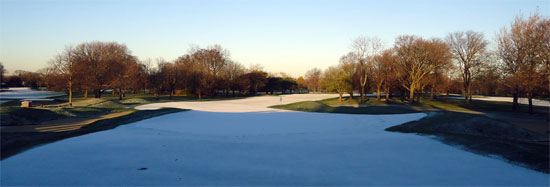
Visit the Park Ridge blog at parkridgeccgrounds.blogspot.com.
|
 |
|
2012: A Summer to Remember...
Ben Rink, Champaign Country Club, Champaign, IL:
 "Ask anyone who spent any time outdoors this summer and they will tell you that 2012 was brutal. We should have known, as March brought with it temperatures in the low 90's and was relatively dry. Despite a cool snap in April, summer was here and it was set to challenge golf course personnel in ways we have not been challenged since 1988, some even say the dust bowl. We broke records all summer with the high heat and lack of rain, and the efforts put forth by the CCC Grounds Staff were monumental. Below are some 'interesting facts' about the summer of 2012...
- Starting in March, it was confirmed that Illinois had just come off the third warmest winter on record.
- Also in March, central Illinois was added to the US Drought Monitor as being 'abnormally dry'.
- March became the warmest March on record with an average temperature of 54.7 degrees. A full 14.1 degrees above normal!
- After a relatively cool April, May became the 5th warmest on record. A warm May finished off the warmest spring on record. Year-to-date, 2012 had become the warmest January to May on record.
- By the end of June, Champaign County was in a moderate drought and was verging on a severe drought according to the US Drought Monitor. At this point 89% of the state was in some sort of drought.
July went into the record books as being the 2nd hottest and 4th driest on record. Only the dust bowl years eclipsed these records... |
- July went into the record books as being the 2nd hottest and 4th driest on record. Only the dust bowl years eclipsed these records. The US Drought Monitor indicated that 71% of the state (including Champaign County) was in a D3 or "extreme" drought. Crop loss reports began piling up.
- During the month of July, we used just over 7.5 million gallons of water to keep CCC alive. One third of this amount or 2.5 million gallons were used through hand watering with hoses. On many occasions we had six staff members at a time hand watering dry areas to keep them alive. This proved to be a game changer in our quest to keep CCC green.
- The month of August finally gave us 'normal' conditions with the average temperature 0.1 degree below normal and rainfall at 95% of normal.
- September actually was slightly below normal for temperatures and above normal for precipitation. Discussions of the drought subsiding were common and turf recovery went into high gear.
...many courses in our area were using upwards of 500,000 gallons of water each night to keep up with the drought. We never topped 250,000 gallons per night at CCC. |
Despite broken records, an historical drought and a summer that started in March, we survived. Water was king this summer and courses that didn't use it enough or who ran short suffered miserably. I feel fortunate that we have ample water available to us however we will always be vigilant on how much we use. We saw first hand this July that, while we have plenty of water available, it is not free! Our approach to hand water as much as we did not only helped save our turf, but saved a considerable amount of water in the process. I spoke to many superintendents during the summer about irrigation practices and found that many courses in our area were using upwards of 500,000 gallons of water each night to keep up with the drought. We never topped 250,000 gallons per night at CCC.
In retrospect, 2012 was a good year. On the heels of two seasons of turf loss we made it through a very difficult summer in good shape. The difference? We were in control of the water for the entire season! A member told me this summer 'this place loves to be dry!' and I would have to say that he was spot on with that statement. Our major turf loss comes during times of too much water and high temperatures. Our course cannot shed water fast enough, remains saturated for long periods of time, and suffers through wet stretches. When we are in control of the water, we see far healthier turf!
Looking ahead, no one knows what 2013 will bring. My hope is that it will bring moderate temperatures with occasional light rain... only at night... and only when we need it."
Visit Ben's blog at cccgolfcourseupdate.blogspot.com.
|
 |
|
Practice Putting Green Renovation...
Josh Clevenger, Claremont Country Club, Oakland, CA:
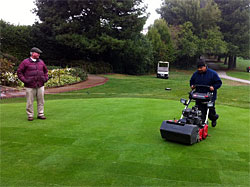
Elio and the inaugural mowing of the putting green
|
 "The putting green renovation is now complete! After a long few weeks, the green is now grassed and believe it or not, was mowed for the first time yesterday. The main reason for this project was to address the drainage issues that have caused problems for us in both winter and summer.
While working on the putting green, we also addressed a few other issues in the area. A french drain was installed around the Presidents room to catch water that comes off of the parking lot and keep it from going under the clubhouse. We adjusted the spacing on the irrigation around the putting green, installed new sprinkler heads and we performed a much needed root pruning around the Oak tree. With the installation of over 1000 feet of drain pipe and the addition of 75 tons of sand to the root zone mix, this green will be the top performer on the property year around.
...due to the lack of rooting, the turf had to be cut in 1' x 1' squares, loaded onto plywood and hauled off. |
The first step in the process was the removal and storage of the existing turf. This process was quite slow and due to the lack of rooting, the turf had to be cut in 1' x 1' squares, loaded onto plywood and hauled off. The green itself is about 6000 square feet so just think, almost 6000 pieces of 100+ year old Claremont Poa being carted off to sit on plastic for a few weeks! No worries!! Step two was the removal of all of the sand that had accumulated from years of sand topdressing. The sand was scraped down to the native clay soil and hauled off to be blended with 75 tons of fresh sand.
Leading the way on this project was Roger Downing of Earth Sculptures and a big thank you goes out to him and his team. A very busy few weeks for all involved! Follow the pictures and descriptions below for the complete rundown on the hows and whys of a putting green renovation:
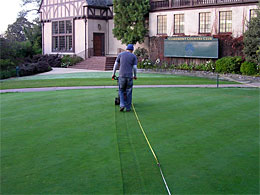
Elio and the inaugural mowing of the putting green.
| 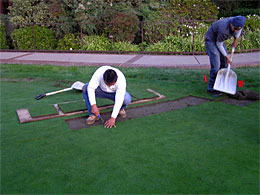
Cutting and removing the sod.
| 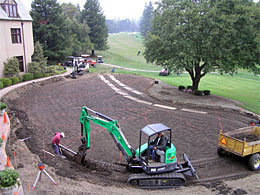
Excavator digging drainage trench.
| 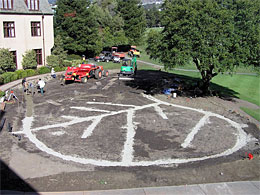
Drain pipe and pea gravel installed into trenches.
| 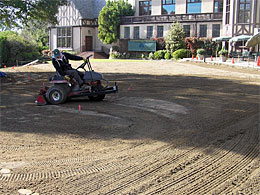
Working soil amendments into the root zone and finish grading.
| 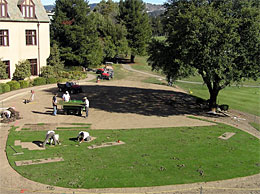
Laying sod - slow and tedious.
|
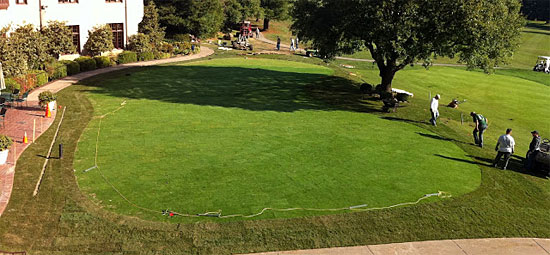
Grassing the surround - All done just in time for rain!
|
We are very happy with the project and we feel like we've addressed a real issue with the drainage and root zone on the putting green. The old putting green had no internal drainage and an inconsistent 3" to 8" of sand root zone. The new putting green has over 1000' of drainage and a consistent 8" of sand across the entire green. Once fully grown in, this green will be the first to be mowed after a big rain storm a opposed to the last.
We hope to open the green sometime in mid December and this will very much depend on the weather. We expect the green to be up to speed with the greens on the course sometime this spring. A big thank you go to the Board of Directors, the Green Committee and all of the members at Claremont for their support on this one.
More photos on Josh's blog at claremontturf.blogspot.com.
|
 |
 |
|
About our Blog Aggregator: Many superintendents are now hosting private blogs to better communicate with their golfers and/or members. Beyond local weather and course conditions, there is a great deal of information about projects, methodologies and techniques that would be of value to other superintendents — hence our Turf Blog Aggregator. As every blogger struggles occasionally with content, we also include posts intended to educate golfers about turf maintenance for others to use as a template for their own blogs.
Miss any previous issues of TBA? You can find them all here.
Turf Blog Aggregator(TM) is a trademark of Turnstile Media Group.
|
|


















